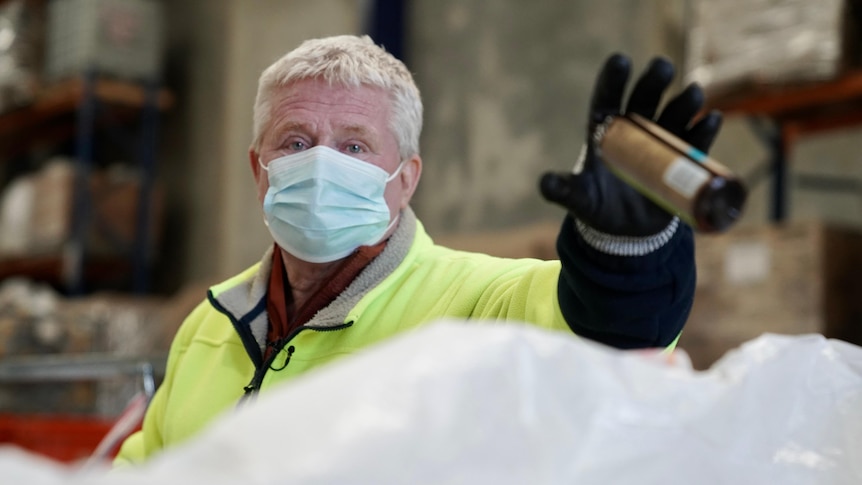Australians spend billions of dollars on beauty products every year, but the leftover packaging mostly ends up in landfill.
It’s estimated that more than 10,000 tonnes of cosmetic waste goes to landfill every year in Australia, because make-up products aren’t generally accepted in kerbside recycling.
That’s because they are too small to be sorted at a regular facility and often contain complex and mixed materials as well as remnant product, which makes them tricky to recycle alongside regular glass and plastics.
So what should you be doing with your old make-up and perfumes?
What are companies doing?
More Australian and international beauty brands and retailers are now offering take-back schemes where you can return used beauty products in-store so they can be recycled.
The products, including skin cream tubes, plastic and metal eyeshadow palettes, foundation and fragrance bottles are sorted into different waste streams like glass, metal, soft and hard plastics.
They are then sent off for processing to be transformed into other products.
What the waste ends up as depends on the company that is doing the recycling and what the packaging was made out of.
Australian recycling company Close the Loop turns plastics into an asphalt additive used in roads.
It said some hard plastics could be shredded and used as a concrete additive, while glass could be crushed and used as a sand replacement for buildings in the construction industry.
Other companies like TerraCycle say their recycled plastic waste can be used in garden beds, outdoor playgrounds and fences.
Who is doing the recycling?
At this stage, it is private companies and not local councils taking charge of recycling in the beauty and cosmetics industries.
Close the Loop recently announced a cosmetics collection trial with retail giant Myer, where consumers can bring back any used make-up items to a participating store until mid-September.
MAC Cosmetics is also part of that trial, which will help investigate how feasible a national beauty recycling scheme is.
The Close the Loop trial has been funded by a million-dollar grant from the federal government.
A spokesperson from the federal Department of Environment said it was funding the trial because cosmetics were difficult to recycle “through normal processes.”
“The project will establish a cosmetic recycling scheme by developing a comprehensive collection network that will collect, process, and recycle waste from cosmetic makeup products,” the spokesperson said.
Major beauty retailers such Mecca, David Jones, Jurlique, Olay, Sukin and Schwarzkopf are also investing in recycling schemes, partnering with international company TerraCycle.
Jean Bailliard is the chief executive of TerraCycle Australia/NZ, which recently partnered with French multinational Sephora.
“We form partnerships with brands and retailers like Sephora that pay for the collection and recycling,” he said.
It means the brands foot the bill.
“We’re not relying on the value of the plastic to cover our costs,” he said.
“We get that funding from the industry that wants to do the right thing.”
Jennie Downes, a researcher from Monash University’s Sustainable Development Institute, said recycling cosmetic products was in its early days and not yet economically viable.
“It’s difficult for [new] recycling schemes to compete against the huge amount of plastic that is currently being produced and pumped out onto the market,” she said.
She said there was also an issue with whether there was enough demand for the recycled products, which is not only a challenge for the beauty industry but for recycling in general Australia-wide.
What can’t be recycled?
Different schemes have different rules, so it is best to check with the place you are returning your packaging to see what things they can take.
Generally, take-back schemes can take things like hand or body creams, eyeshadow, eyeliner, mascara, or any other hair or skincare products.
They have difficulty accepting aerosols and nail polish, which are made up of complex materials and can also be flammable.
TerraCycle and its partner brands won’t accept aerosols or nail polish as it said they are difficult to transport via post.
TerraCycle also said it was only able to recycle empty packaging.
The government-funded Myer trial with Close The Loop is testing accepting products like aerosols and nail polish, to see if they can work out how to safely transport and recycle them.
That trial will also accept packaging with remnant products, though most take-back schemes require the returned products to be empty.
How do I know if the products are actually being recycled?
This is a tricky one, but researcher Jenni Downes said it was best to have faith that companies were doing the right thing and to build a habit of trying to recycle products that you might have tossed in the bin before.
“There definitely is some skepticism and mistrust out there, that businesses may be greenwashing,” she said.
“Being transparent about how much is being returned, what it’s been turned into, whether it’s happening locally or overseas, I think this sort of information really increases people’s trust.”
Ms Downes said in terms of the numbers of recycled products or the types of things they are turned into, the numbers will probably be small at the beginning.
“That’s okay, because they are new,” she said.
“But they can tell that story as well as releasing the data … because if they don’t share that information, it’d be difficult for customers to trust them.”
She said the other thing worth thinking about was switching to refillable products, which were growing in popularity on the market.
“Recycling is definitely a last line of defense and looking at things further up the hierarchy, like reuse and refillable packing would also be great,” she said.
.
